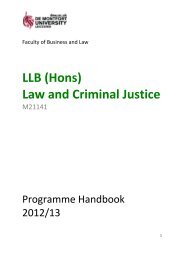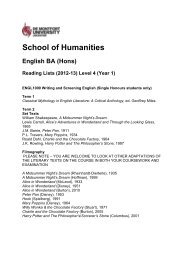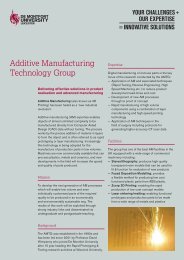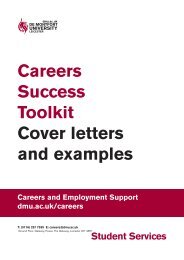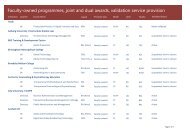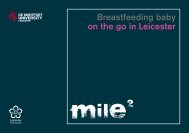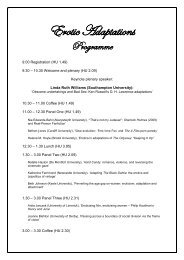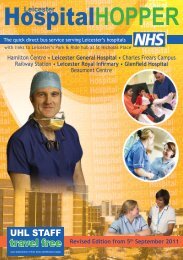Evaluation of the Crash Course March 2009 - De Montfort University
Evaluation of the Crash Course March 2009 - De Montfort University
Evaluation of the Crash Course March 2009 - De Montfort University
You also want an ePaper? Increase the reach of your titles
YUMPU automatically turns print PDFs into web optimized ePapers that Google loves.
or ‘one-liners’ to use in response to pressure. One example might be to go out<br />
always equipped with <strong>the</strong> bus or taxi fare in case <strong>of</strong> an emergency need to refuse a<br />
lift with an irresponsible driver. Some stakeholders suggested that first aid training<br />
for young people would also contribute to <strong>the</strong> ability to cope with a road collision. The<br />
coping strategies should also acknowledge <strong>the</strong> pressures from peers and <strong>the</strong> need<br />
to fit in and establish an image and identity.<br />
In view <strong>of</strong> <strong>the</strong> poor levels <strong>of</strong> awareness on <strong>the</strong> effects <strong>of</strong> alcohol, somewhat more<br />
emphasis might also be placed on this issue. Young people need to realise that<br />
judgement and coordination are affected long before a person appears seriously<br />
drunk.<br />
Follow up is weaker than it might be. Some schools do take up <strong>the</strong> topic in tutor<br />
group discussions after <strong>the</strong> presentation but few take consistent opportunities to<br />
reinforce <strong>the</strong> messages in o<strong>the</strong>r parts <strong>of</strong> <strong>the</strong> curriculum. There is a missed<br />
opportunity here. O<strong>the</strong>r road safety interventions can also play a part in reinforcing<br />
<strong>the</strong> learning. Young people have also suggested involving parents. If this could be<br />
achieved, <strong>the</strong> probable follow up in family discussion might also reinforce impact.<br />
Assertiveness training would be extremely valuable as follow up, both in relation to<br />
avoiding dangerous situations and in respect <strong>of</strong> peer pressure.<br />
No written material is currently supplied with <strong>the</strong> course. There is a need for a<br />
handout that can be given to <strong>the</strong> young people for reference to reinforce <strong>the</strong><br />
essential messages <strong>of</strong> <strong>the</strong> course. This should address directly key steps that young<br />
people can positively take to make <strong>the</strong>mselves safer and reduce risk even before<br />
<strong>the</strong>y are drivers. It is essential not to leave people with a sense <strong>of</strong> helplessness at<br />
<strong>the</strong> end <strong>of</strong> <strong>the</strong> input. Such a handout might be combined with information on o<strong>the</strong>r<br />
road safety resources and <strong>the</strong> contact details <strong>of</strong> support agencies.<br />
Some young people suggested <strong>the</strong> use <strong>of</strong> activities within <strong>the</strong> presentation itself. As<br />
it is, <strong>the</strong> course is in danger <strong>of</strong> being a little too long so major interactive work is<br />
unlikely to be feasible. A short exercise like a quiz might possibly work well to vary<br />
<strong>the</strong> dynamic <strong>of</strong> <strong>the</strong> session. O<strong>the</strong>r activities such as those around <strong>the</strong> effects <strong>of</strong><br />
alcohol or computer-based hazard reaction exercises could well be part <strong>of</strong> follow up<br />
work.<br />
There is a danger that young people will become negative towards <strong>the</strong> safety<br />
messages if <strong>the</strong>y feel that <strong>the</strong>y are being blamed for dangerous driving on <strong>the</strong> roads.<br />
There was certainly some evidence from <strong>the</strong> focus groups that some felt <strong>the</strong>y were<br />
being made scapegoats for <strong>the</strong> reckless behaviour <strong>of</strong> some adult drivers. This will<br />
require careful nuancing <strong>of</strong> <strong>the</strong> way in which <strong>the</strong> risks are expressed. Affirmation <strong>of</strong><br />
<strong>the</strong> basic common sense <strong>of</strong> young people and <strong>the</strong> wish <strong>of</strong> <strong>the</strong> majority to stay safe<br />
should be emphasised in <strong>the</strong> presentation.<br />
The evidence confirms <strong>the</strong> risk-taking tendencies <strong>of</strong> young males and also suggests<br />
a link to deprivation. This is <strong>of</strong> huge concern for <strong>the</strong> development <strong>of</strong> more effective<br />
road safety education. Fur<strong>the</strong>r exploration is needed for <strong>Crash</strong> <strong>Course</strong> to seek topics<br />
or styles that might fur<strong>the</strong>r harness <strong>the</strong> motivation <strong>of</strong> young men to act safely. One<br />
possible avenue for consideration might be to suggest that ‘grown up’ adult men (‘big<br />
men’) protect <strong>the</strong>ir ‘mates’ and <strong>the</strong>ir loved ones ra<strong>the</strong>r than putting <strong>the</strong>m at risk. In<br />
68





